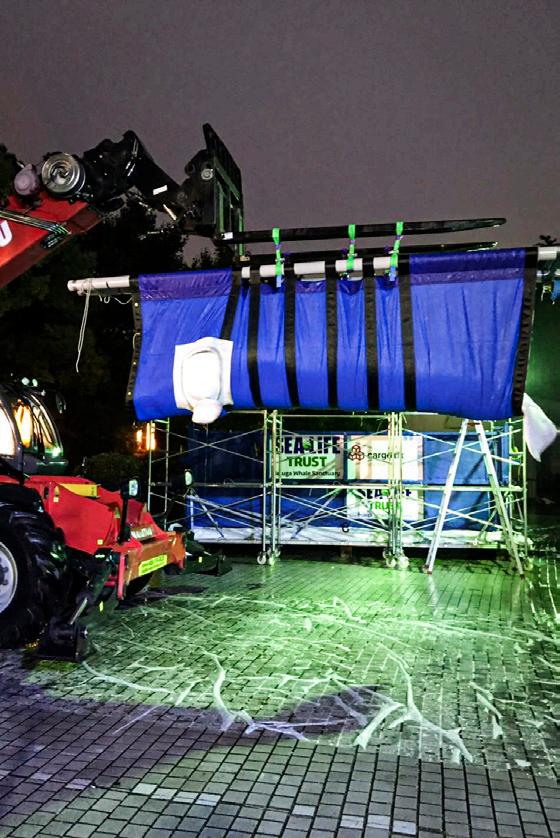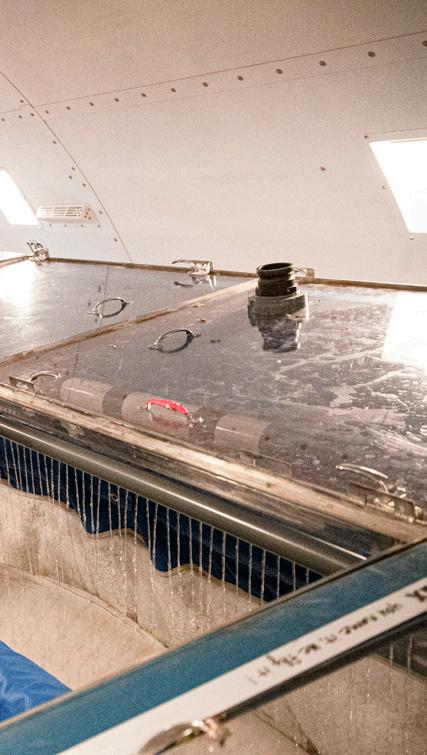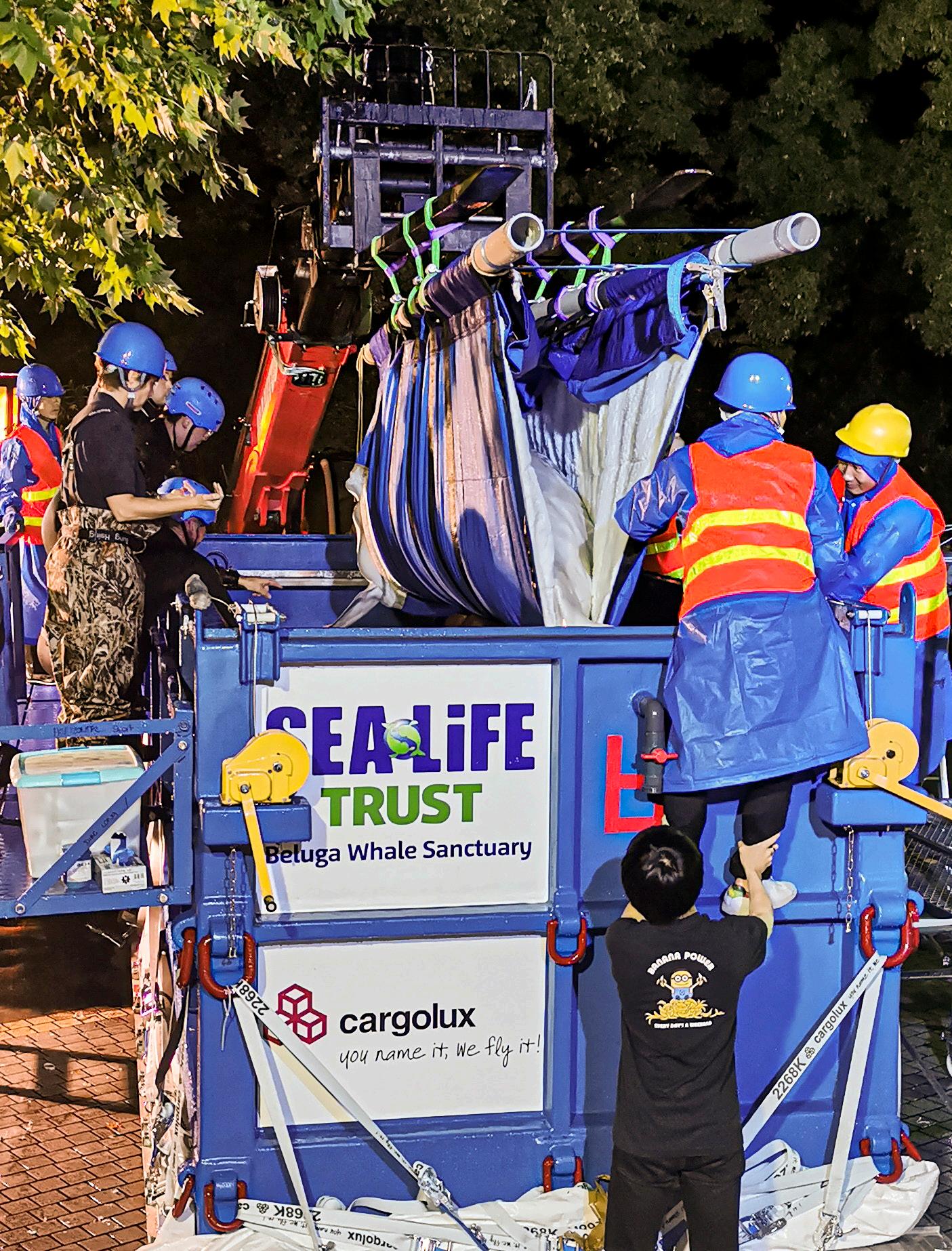
5 minute read
SUCCESSFUL TEAMS


AS A SPONSOR OF THE PROJECT, OPERATING THE FLIGHT FREE OF CHARGE, CARGOLUX
WAS HEAVILY INVOLVED
THROUGHOUT THE PROCESS.
THE BIG DIFFERENCE BETWEEN THIS FLIGHT AND OTHER ANIMAL TRANSPORTS WAS THE SCALE OF COMPLEXITY. INDEED, DESPITE WORKING IN THE INDUSTRY FOR ALMOST 50 YEARS, CERTAIN ASPECTS OF THE PROJECT WERE ENTIRELY NEW TO CARGOLUX.

MEET CARGOLUX TEAMS


Cargolux Teams Go the Extra Mile
TRANSPORTING ANIMALS IS AN INTERESTING CHALLENGE. THE UNNATURAL SURROUNDINGS, PRESSURE AND MOTION CAN CAUSE DISTRESS TO EVEN THE MOST RESILIENT CREATURES, SO WHEN YOU CARRY TWO LARGE MAMMALS THAT NEED TONNES OF WATER, THINGS CAN GET TRICKY. OUR MULTIDISCIPLINARY TEAM OF EXPERTS WORKED TOGETHER TO ANALYZE, ASSESS, AND FIND SAFE SOLUTIONS.
For almost a year, the Cargolux teams in both Luxembourg and Shanghai worked with international partners to cover all aspects of an incredible journey. From planning to loading and unloading, every facet of the flight was monitored by dedicated employees who went above and beyond to guarantee a successful outcome.
Success!
As the aircraft touched down in Keflavík, emotions were high. The specially branded freighter taxied in to a delighted team. The operating crew, Captains Claude Zehren and Brynjar Sveinjonsson, and First Officer Joe Diebolder, were greeted enthusiastically after safely delivering the two belugas to their new forever home. The flight went swimmingly, Claude explained after landing in Iceland. “The voyage was smooth and uneventful, which reflects the detailed groundwork and exceptional preparation that everyone invested in the project. Indeed, months of behind-the-scene planning and analyzing took place before this epic journey.”
Overcoming Challenges
During the project, an extensive risk assessment determined the requirements for a safe and smooth flight. All potential risks were identified and analyzed to create adapted solutions. “In addition to the regular safety requirements, items specific to the transport of the belugas were addressed; the requirements for care teams and veterinarians on board, safe access to the whales in flight, safe water transfer and temperature control, possible diversion airports, routing, and turbulence were just a few considerations,” explained Mattias Pak, Head of Aviation Safety. For each challenge, a suitable solution was found. Due to the complexity of the project, the multidisciplinary coordination, and the integration of the risk assessment, many Cargolux departments were involved, including Ground Operations, Flight Operations, and Engineering (System and Avionics), as well as Aviation Safety. There had never been such huge amount of water (up to 7,000 liters) in the air so forces from water sloshing and the risk of spillage on board had to be considered. It was also the first time that a camera system was used on the main deck for the care team to supervise the belugas during take-off and landing.
One of the most complex aspects, carefully analysed by the Cargolux teams, was the aircraft weight and balance. Michael Verhuelsdonk, the Ground Operations Engineer who traveled on board, explains: “Our main concerns related to in-flight water transfer and the resulting change of the aircraft’s center of gravity. To reduce the influence of water transfer, the beluga tanks and the spare water tanks were placed as close as possible to the center of gravity to avoid large weight changes. Simulations before the flight ensured that under no circumstance would the aircraft’s center of gravity exceed the limits.”
The Cargolux and beluga care teams worked together to strike a balance between the whales’ requirements and the operational safety of the flight. According to Marc Roveri, Head of Global Customer Services: “The biggest challenge was to meet the shipper’s requirements for the well-being of the whales while complying with physical constraints. We came up with the solution of lowering the amount of water during take-off and landing and increasing it at cruising altitude. Almost 3 tonnes of water per tank had to be moved in and out.”
These various constraints required patience and hard work from our teams who faced a number of complex issues throughout the project. The original design of the containers, although very well conceived in terms of stability, was also modified to strengthen operational safety. To ensure secure transport, features such as footprint, location, required rating of lugs, and elements related to the risk assessment were considered.
Shanghai Involvement
The Cargolux team in Shanghai focused on securing authorizations and assisted with documentation, to confirm a smooth transit. With the plethora of organizations involved, the Shanghai team coordinated all parties’ requests and assisted with administrative tasks and airport authorities’ requirements. Shanghai’s Pudong airport (PVG) is one of the busiest in the world; security, safety, and slots are tight all day. Numerous aspects such as ramp accesses, customs clearances, and warehouse arrangements had to be prepared ahead.
To ensure a smooth loading and clearance process, the team in PVG

LUGS
LOCATION AND REQUIRED RATING REQUESTED TO ENSURE AN EFFECTIVE SECURING INSIDE THE AIRCRAFT.
CLOSED LID
FULLY CLOSED DURING TAKEOFF AND LANDING WITH THE POSSIBILITY TO OPEN THE LID AT FLIGHT LEVEL FOR BETTER ACCESS TO THE BELUGAS.
did the footwork and made the necessary provisions well ahead of the belugas’ departure date. They were involved in the coordination and timing of critical elements for the timely loading of the precious cargo including arrangements with the relevant parties for acceptance, security, and handling as well as the load plan, pallet building, ULD and material control.
Cargolux’s engineer, Michael Verhuelsdonk, received local training on the water system operation on LX-ECV. The main focus was its setup, adapting the water level in the containers, assessing and reacting to any malfunctions or leaks in the system. With the team in Shanghai, he supervised the loading, ensured the containers were properly secured and that the support system was fully functional.
When the flight crew arrived, they coordinated closely with the teams on the ground and those traveling on board to ensure full transparency of everyone’s roles. The pilots avoided turbulence throughout the flight and maintained a low altitude, following the vets’ recommendations.
FOOTPRINT
ADDITIONAL LATERAL SUPPORTS REQUESTED TO NOT EXCEED THE AIRCRAFT FLOOR LIMITATIONS.
Global Project Integration
The airline was truly involved throughout the transport procedure and provided assistance every step of the way. What really differentiated this live animal transport from the others that Cargolux routinely undertakes was the wide-ranging involvement of team members. As Marc highlights: “There were certain gaps where Cargolux had to create solutions. We dealt with many issues that normally, as an airline, we don’t oversee. In retrospect, it was a benefit that we were so highly involved, even for these issues.”
It is no secret that the beluga flight was a huge undertaking that required months of planning and preparation to guarantee the whales welfare and to address stringent operational constraints. The successful outcome is a true reflection of the dedication and hard work that drives Cargolux teams.





